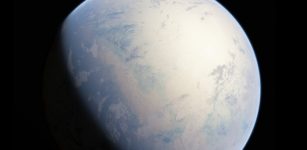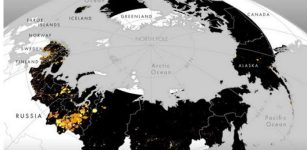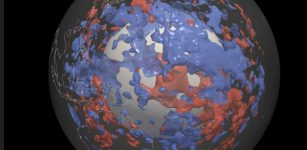Phytoplankton Shield Ice Shelves From Summer Heat
Eddie Gonzales Jr. – MessageToEagle.com – In spring, stretches of Antarctic sea ice melt to form pockets of open water called polynyas, which make perfect homes for phytoplankton. These marine microbes can become so abundant that they turn the water green.
Melt rates in the Amundsen Sea, such as from the Getz Ice Shelf (pictured), would be higher without the influence of nearby phytoplankton blooms, according to new modeling. Credit: NASA/Jeremy Harback
In an article published in the Journal of Geophysical Research: Oceans, Andrew Twelves and colleagues examined how these verdant microalgae change the flow of heat through ocean water and affect nearby ice shelves in West Antarctica’s Amundsen Sea.
Combining a model for studying fluid circulation called MITgcm with a model for studying biogeochemical processes called Biology Light Iron Nutrient and Gas (BLING), the researchers studied how the chlorophyll contained in these phytoplankton scatters sunlight and influences the temperature of the ocean.
Phytoplankton trap heat in the upper level of seawater, the researchers found. However, this heat dissipates back into the atmosphere over the course of the summer. Meanwhile, the phytoplankton also provide shade to deep water, keeping it cool and limiting the effect of sunlight on nearby ice shelves.
As a result, these ice shelves melt 7% more slowly when blooms are present than when the water is clear—that’s helpful for ice shelves threatened by climate change.
Feedback between the ice and iron supply limits how much phytoplankton can protect ice shelves, however. Sediments released from melting ice provide iron that supports microbial growth; phytoplankton may stunt their own proliferation when they slow ice shelf melting.
As Antarctic waters lose their sea ice cover, larger areas of the sea surface will be exposed to sunlight. Microbes and other particles can influence how this sunlight affects the ocean, and they deserve additional attention in future studies, the authors write.
Paper
A. G. Twelves et al, Chlorophyll Production in the Amundsen Sea Boosts Heat Flux to Atmosphere and Weakens Heat Flux to Ice Shelves, Journal of Geophysical Research: Oceans (2024). DOI: 10.1029/2024JC021121
Written by Eddie Gonzales Jr. – MessageToEagle.com Staff Writer











